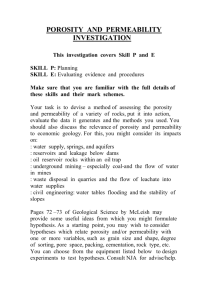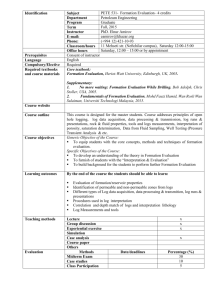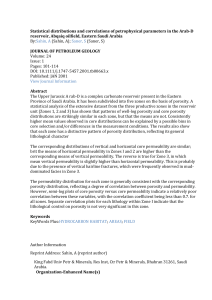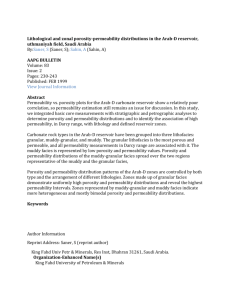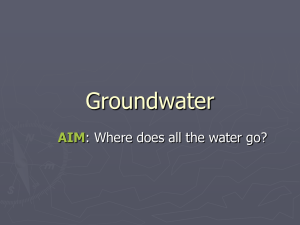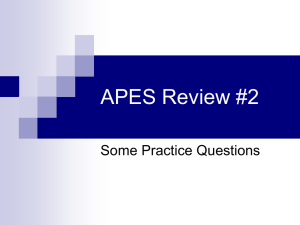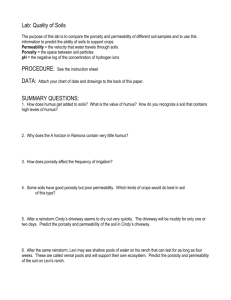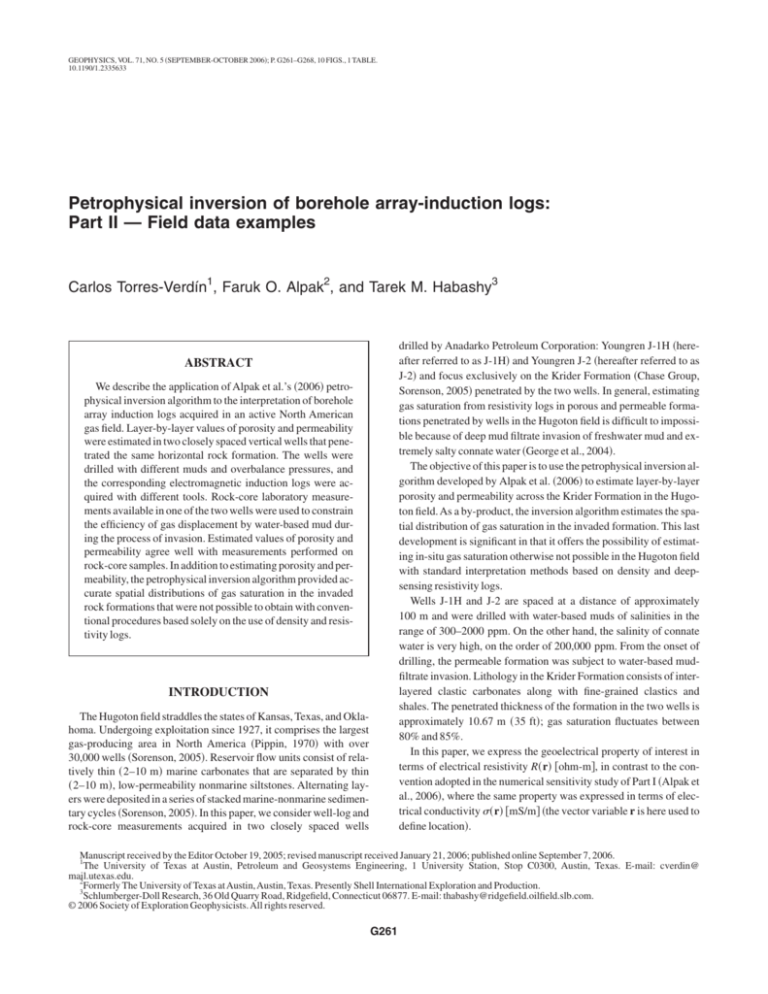
GEOPHYSICS, VOL. 71, NO. 5 共SEPTEMBER-OCTOBER 2006兲; P. G261–G268, 10 FIGS., 1 TABLE.
10.1190/1.2335633
Petrophysical inversion of borehole array-induction logs:
Part II — Field data examples
Carlos Torres-Verdín1, Faruk O. Alpak2, and Tarek M. Habashy3
drilled by Anadarko Petroleum Corporation: Youngren J-1H 共hereafter referred to as J-1H兲 and Youngren J-2 共hereafter referred to as
J-2兲 and focus exclusively on the Krider Formation 共Chase Group,
Sorenson, 2005兲 penetrated by the two wells. In general, estimating
gas saturation from resistivity logs in porous and permeable formations penetrated by wells in the Hugoton field is difficult to impossible because of deep mud filtrate invasion of freshwater mud and extremely salty connate water 共George et al., 2004兲.
The objective of this paper is to use the petrophysical inversion algorithm developed by Alpak et al. 共2006兲 to estimate layer-by-layer
porosity and permeability across the Krider Formation in the Hugoton field. As a by-product, the inversion algorithm estimates the spatial distribution of gas saturation in the invaded formation. This last
development is significant in that it offers the possibility of estimating in-situ gas saturation otherwise not possible in the Hugoton field
with standard interpretation methods based on density and deepsensing resistivity logs.
Wells J-1H and J-2 are spaced at a distance of approximately
100 m and were drilled with water-based muds of salinities in the
range of 300–2000 ppm. On the other hand, the salinity of connate
water is very high, on the order of 200,000 ppm. From the onset of
drilling, the permeable formation was subject to water-based mudfiltrate invasion. Lithology in the Krider Formation consists of interlayered clastic carbonates along with fine-grained clastics and
shales. The penetrated thickness of the formation in the two wells is
approximately 10.67 m 共35 ft兲; gas saturation fluctuates between
80% and 85%.
In this paper, we express the geoelectrical property of interest in
terms of electrical resistivity R共r兲 关ohm-m兴, in contrast to the convention adopted in the numerical sensitivity study of Part I 共Alpak et
al., 2006兲, where the same property was expressed in terms of electrical conductivity 共r兲 关mS/m兴 共the vector variable r is here used to
define location兲.
ABSTRACT
We describe the application of Alpak et al.’s 共2006兲 petrophysical inversion algorithm to the interpretation of borehole
array induction logs acquired in an active North American
gas field. Layer-by-layer values of porosity and permeability
were estimated in two closely spaced vertical wells that penetrated the same horizontal rock formation. The wells were
drilled with different muds and overbalance pressures, and
the corresponding electromagnetic induction logs were acquired with different tools. Rock-core laboratory measurements available in one of the two wells were used to constrain
the efficiency of gas displacement by water-based mud during the process of invasion. Estimated values of porosity and
permeability agree well with measurements performed on
rock-core samples. In addition to estimating porosity and permeability, the petrophysical inversion algorithm provided accurate spatial distributions of gas saturation in the invaded
rock formations that were not possible to obtain with conventional procedures based solely on the use of density and resistivity logs.
INTRODUCTION
The Hugoton field straddles the states of Kansas, Texas, and Oklahoma. Undergoing exploitation since 1927, it comprises the largest
gas-producing area in North America 共Pippin, 1970兲 with over
30,000 wells 共Sorenson, 2005兲. Reservoir flow units consist of relatively thin 共2–10 m兲 marine carbonates that are separated by thin
共2–10 m兲, low-permeability nonmarine siltstones. Alternating layers were deposited in a series of stacked marine-nonmarine sedimentary cycles 共Sorenson, 2005兲. In this paper, we consider well-log and
rock-core measurements acquired in two closely spaced wells
Manuscript received by the Editor October 19, 2005; revised manuscript received January 21, 2006; published online September 7, 2006.
1
The University of Texas at Austin, Petroleum and Geosystems Engineering, 1 University Station, Stop C0300, Austin, Texas. E-mail: cverdin@
mail.utexas.edu.
2
Formerly The University of Texas at Austin, Austin, Texas. Presently Shell International Exploration and Production.
3
Schlumberger-Doll Research, 36 Old Quarry Road, Ridgefield, Connecticut 06877. E-mail: thabashy@ridgefield.oilfield.slb.com.
© 2006 Society of Exploration Geophysicists. All rights reserved.
G261
G262
Torres-Verdín et al.
WELL LOGGING
of the gas-bearing formation is low, on the order of 15%, giving rise
to deep invasion.Amajor challenge faced in evaluating the gas reserWell J-2 was drilled using a heavy freshwater-based mud, causing
voir penetrated by well J-2 is that the deep invasion of mud filtrate
an overbalance pressure approximately equal to 7.3 MPa. Porosity
adversely affects the response of electrical resistivity measurements. Indeed, Dual Induction Imager Resistivity Tool logs 共DIL, hereafter referred
to as dual-induction logs兲 acquired in well J-2
共Figure 1兲 exhibit a reverse resistivity profile
where deep dual-induction 共ILD, hereafter referred to as deep dual-induction兲 readings 共20–
22 ohm-m兲 are lower than the medium dual-induction 共ILM, hereafter referred to as medium
dual induction兲 readings 共25–30 ohm-m兲. Average readings of deep and medium dual-induction
logs are lower than the shallow readings 共90–
100 ohm-m兲 acquired with the spherically focused microresistivity tool 共MicroSFL兲 and the
spherically focused resistivity tool 共SFL兲.
By contrast, well J-1H was drilled with a light
foam-based mud, resulting in very shallow invasion. The overbalance pressure for well J-1H
was much lower than the one enforced to drill
well J-2. Resistivity logs acquired in well J-1H
showed a normal resistivity profile across the
Krider Formation 共Figure 2兲. On average, array
induction imager tool 共AIT, hereafter referred
to as array induction tool兲 readings are 50–
60 ohm-m for the 90-inch log, 40–50 ohm-m for
the 60-inch log, and 30–35 ohm-m for the 10Figure 1. Plot of the basic suite of wireline logs, including dual-induction measurements,
inch log. Well J-1H is considered a key well in the
acquired in well J-2. Depths are given in meters below the well’s kelly bushing. The neutron log 共NPHI兲 is expressed in limestone porosity units.
present study because of both shallow invasion
and the availability of extensive log and rockcore measurements 共rock-core measurements
were not available in well J-2兲. This well provides
a unique reference to quantify the reliability and
accuracy of the petrophysical inversion of induction logs to estimate permeability and porosity. In
addition, the complete suite of measurements
provides a benchmark to quantify the effect of
mud-filtrate invasion on resistivity logs acquired
along the Krider Formation in well J-2.
LAYER PARAMETERS
Figure 2. Plot of the basic suite of wireline logs, including array-induction measurements, acquired in well J-1H. Depths are given in meters below the well’s kelly bushing.
The neutron log 共NPHI兲 is given in limestone porosity units.
For the purpose of parametric petrophysical inversion of induction logs acquired in wells J-1H
and J-2, we constructed a 2D cylindrical formation model with a vertical well at its center. The
vertical borehole penetrates the gas-bearing
Krider Formation, consisting of isotropic permeable horizontal layers. As shown in the vertical
cross section of Figure 3a, the formation is shouldered by impermeable shale layers. Resistivities
of the upper and lower shoulder beds are also displayed in Figure 3a. Measurements conducted on
mud-filtrate samples indicated that the salinity of
mud filtrate in wells J-2 and J-1H was approximately 2000 and 340 ppm, respectively. Downhole fluid samples taken within the formation of
Petrophysical inversion, field examples
interest revealed the salinity of connate water was approximately
200,000ppm.
Based on the interpretation of rock-core data and density logs, we
described the formation of interest with three isotropic horizontal
layers of thicknesses 4.57 m, 2.44 m, and 3.66 m. Prior to inverting
the induction logs, the values of permeability and porosity for each
layer were estimated from rock-core measurements acquired in well
J-1H. These values are also displayed in Figure 3a. The constant core
porosity and permeability values assigned to each layer were obtained by arithmetic and logarithmic averaging, respectively, of the
actual core measurements. Statistical dispersion of the core porosity
and permeability measurements about the assigned constant layer
values is negligible for all practical purposes.
PVT AND FLUID PROPERTIES
We assumed instantaneous temperature equilibrium between
mud-filtrate and in-situ fluids. This assumption renders the mud-filtrate invasion phenomenon an isothermal flow of two immiscible
fluid phases 共namely gaseous and aqueous phases兲 in a permeable
rock formation. For the gaseous phase, we used laboratory pressure,
volume, and temperature 共PVT兲 measurements to constrain density,
viscosity, formation volume factor, z-factor, and
compressibility relationships as a function of
pressure. Laboratory measurements of density,
viscosity, formation volume factor, and compressibility as functions of salt concentration are
used for the aqueous phase — more specifically,
mud filtrate. Table 1 describes the numerical values of the PVT properties of the gaseous phase at
a reference pressure of 1 atm 共surface conditions兲
along with the PVT properties of the aqueous
phase.
G263
ARCHIE’S EQUATIONS AND
PARAMETERIZATION
The use of Archie’s equations in the present study is justified given the clastic nature of the carbonate sequence under consideration.
Also, the high salinity of connate water makes it unnecessary to correct for the presence of clay in Archie’s equations. Parameters used
in Archie’s saturation equation are listed in Table 1. For the formation under consideration, laboratory measurements consistently indicated marginal statistical variability of Archie’s parameters.
Therefore, we made no further attempt to quantify the impact of uncertainty in Archie’s parameters on the inverted values of porosity
and permeability.
We computed the spatial distribution of the initial aqueous-phase
saturation within the formation of interest using conventional inversion of array induction logs acquired in well J-1H. Specifically,
layer-by-layer spatial distributions of deep resistivity, Rt, were derived by inverting the deepest-sensing induction log for a more finely layered medium. In so doing, we considered an eight-layer parametric model to describe the spatial distribution of Rt. Layer thicknesses for the assumed eight layers were determined from the depth
variability of the array induction logs acquired in well J-1H. The ini-
ROCK-FLUID PROPERTIES
We used the available rock-core data in well
J-1H to constrain relative permeability and capillary pressure functions for each flow unit 共layer兲.
Within the framework of our petrophysical inversion algorithm, laboratory measurements of relative permeability 共Figure 3b兲 performed on cores
extracted from each of the reservoir layers were
input to the near-borehole fluid-flow simulator.
The highly irreducible aqueous-phase saturation
for each layer hints at a strong water-wet system.
In this case, the aqueous phase is the wetting
phase, and the wetting/nonwetting convention of
the relative permeability plot should be interpreted accordingly. Capillary pressure data 共Figure
3c兲 were derived from laboratory measurements
for the drainage cycle for the above layers. Because of the lack of laboratory capillary pressure
for the imbibition cycle, the available drainagecycle data were used for the numerical simulations of the imbibition process, namely, waterbased mud-filtrate invasion in a strongly waterwet system.
Figure 3. 共a兲 Two-dimensional axisymmetric formation model assumed for the inversion
of borehole electromagnetic induction logs acquired in wells J-1H and J-2 across the
Krider Formation. The three-layer formation is subject to water-based mud-filtrate invasion. Permeability and porosity values obtained from rock-core measurements in well
J-1H are shown in the above cross section. 共b兲 Water-gas relative permeability and 共c兲
capillary pressure saturation functions used in the simulation of fluid flow. The subscripts
“rw” and “rnw” in 共b兲 are used to identify relative permeability values for wetting 共in this
case, aqueous兲 and nonwetting 共in this case, gaseous兲 phases, respectively.
G264
Torres-Verdín et al.
tial spatial distribution of the aqueous-phase saturation was derived
using Archie’s equations in conjunction with core porosity measurements. We determined the spatial distribution of gaseous-phase saturation using a saturation identity for two-phase flow and the spatial
distribution of aqueous-phase saturation. The fluid saturation domain was described with a finer spatial parameterization than the
three-layer permeability-porosity parameterization derived from
rock-core measurements. Within the context of the petrophysical inversion algorithm, we used the estimated initial spatial distribution
of aqueous- and gaseous-phase saturations 共determined for the
eight-layer saturation domain兲 to derive the initial condition necessary to simulate mud-filtrate invasion.
INVASION CONSTRAINTS
Samples of mud and mud filtrate in well J-2 provided adequate information to constrain fundamental parameters governing the process of mud-filtrate invasion such as mud-cake growth and effective
flow rate across the mud cake. The flow rate of mud filtrate across the
mud cake was modeled using INVADE 共Wu et al., 2005兲 as a func-
tion of invasion time. Mud-cake parameters required by this computation are documented in Table 1. However, for well J-1H, mud-cake
parameters required to compute the rate of mud-filtrate invasion
were not available. On the other hand, for both wells J-1H and J-2,
the logging record indicated that logs were acquired four days after
the onset of invasion. For filtrate invasion in well J-2, both dynamic
growth of mud-cake thickness and dynamic decrease of mud-cake
permeability remain coupled to formation properties. This process
results in a monotonic decrease of flow rate across the borehole wall.
For the purpose of computing the time-domain flow-rate response of
mud cake, we used rock-core permeability and porosity values acquired in well J-1H. In the present work, the layer-dependent rate of
mud-filtrate invasion is assumed to be the steady-state value yielded
by the simulations of invasion. Since the mud-cake parameters in
well J-1H were not available, the rate of mud-filtrate invasion in well
J-1H was derived from a conventional inversion of electrical resistivity. Using Archie’s equations, we determined the total volume of
mud filtrate that invaded the formation in well J-1H. Subsequently,
given that the duration of invasion was known, an average mudfiltrate invasion rate was determined for well J-1H. Rates of mud-
Table 1. Summary of geometrical, petrophysical, mud cake, fluid, and sensor parameters for the rock formation model assumed
in the inversion of field electromagnetic induction logs.
Variable
Mud-cake permeability 共well J-2兲
Mud-cake porosity 共well J-2兲
Mud solid fraction 共well J-2兲
Mud-cake maximum thickness 共well J-2兲
Formation rock compressibility
Aqueous-phase viscosity 共mud filtrate兲
Aqueous-phase density 共mud filtrate兲
Aqueous-phase formation volume factor 共mud
filtrate兲
Aqueous-phase compressibility 共mud filtrate兲
Gaseous-phase reference viscosity 关f共p兲 for
temperature = const.兴
Gaseous-phase reference density 关f共p兲 for
temperature = const.兴
Formation pressure at the formation top 共at the
reference depth = 0 m兲
Mud hydrostatic pressure 共well J-2兲
Wellbore radius
Formation outer boundary location
Formation temperature
a — constant in Archie’s equation
m — cementation exponent in Archie’s equation
n — aqueous phase saturation exponent in
Archie’s equation
Mud conductivity
Upper-shoulder bed conductivity 共well J-1H兲
Lower-shoulder bed conductivity 共well J-1H兲
Upper-shoulder bed conductivity 共well J-2兲
Lower-shoulder bed conductivity 共well J-2兲
Depth-sampling interval
Unit
Value
mD
fraction
fraction
cm
kPa−1
Pa.s
g/cm3
res. m3 /std. m3
0.030
0.600
0.200
0.254
7.252 ⫻ 10−10
1.000 ⫻ 10−3
1.186
1.000
kPa−1
Pa.s
1.450 ⫻ 10−7
1.087 ⫻ 10−5 @ 1.0 atm
g/cm3
9.781 ⫻ 10−4 @ 1.0 atm
MPa
0.662
MPa
m
m
°C
dimensionless
dimensionless
dimensionless
7.950
0.100
300.000
35.556
1.000
2.000
2.000
mS/m
mS/m
mS/m
mS/m
mS/m
m
387.600
200.000
327.900
200.000
400.000
7.620 ⫻ 10−2
Petrophysical inversion, field examples
G265
of the near-borehole spatial distributions of gas saturation and salt
filtrate invasion for wells J-1H and J-2 were imposed as a source
condition for the fluid-flow module integrated to the petrophysical
concentration, respectively.
inversion algorithm.
Figure 7 shows permeability and porosity values simultaneously
Induction logs acquired in wells J-1H and J-2 consistently indiinverted from induction logs acquired with the array-induction tool
cate increasing shaliness toward the bottom of the Krider Formation.
configuration in well J-1H. Inverted permeability and porosity valThe spatial location of this trend corresponds to the depth segment
ues are shown for two inversion examples where we make use of a
comprised by the third petrophysical layer derived from rock-core
three-layer and a four-layer parameterization of the Krider Formaanalysis. Therefore, for the petrophysical inversions, the third layer
tion. Inverted values are shown together with permeability and posuggested by the rock-core analysis was divided into two separate
rosity values obtained from rock-core analysis in the same well. In
layers. Inversions were then conducted using four layers. A better
this case, we initialized the inversion with uniform permeability and
way of performing the petrophysical inversion would be to parameporosity values. Such initial-guess values are also shown in Figure 7,
terize the formation of interest using many small layers and perform
each panel of which displays a particular inversion outcome.
a 1D inversion of permeability and porosity without assuming the thickness of the layers. However, numerical experiments performed using such
a model discretization proved computationally
prohibitive because of the increased number of
forward simulations required for the computation
of the Jacobian matrix 共Alpak et al., 2006兲.
We first investigated the petrophysical inversion of induction logs acquired in well J-2. Figure
4 shows permeability and porosity values inverted from induction logs acquired with the dualinduction configuration. Inversion results are
shown for two different uniform initial-guess values of permeability and porosity. Inverted values
are shown together with permeability and porosity values derived from core analysis of rock samples acquired in well J-1H 共the core porosity and
permeability values are used solely for comparison purposes兲. We used uniform initial-guess values to assess the reliability of the petrophysical
inversion algorithm. These initial-guess values
are also shown in each panel of Figure 4 that displays a particular inversion result.
Figure 5 describes the quality of the postinversion data fit achieved by inverting dual-induction
logs. In this plot, we compare the simulated meaFigure 4. Permeability and porosity values yielded by the inversion of electromagneticsurements against the actual field measurements
induction logs acquired with the dual induction tool in well J-2. Measurements were acfor the final iteration of the inversion algorithm.
quired four days after the onset of mud-filtrate invasion. Inversion results are shown for
Subsequent to the quantitative estimation of pertwo initial-guess value of permeability and porosity for 共a–b and c–d兲 a four-layer demeability and porosity, we simulated the spatial
scription of the formation of interest. Rock-core measurements of porosity and permeability were acquired in well J-1H and are shown for comparison purposes only.
distributions of near-borehole fluid saturations
and salt concentration. The cross section of electrical conductivity in the invaded Krider Formation was computed from the simulated profiles of
aqueous-phase saturation and salt concentration
via Archie’s equations.
INVERSION OF ELECTRICAL
CONDUCTIVITY
As shown in Figure 6a, the petrophysical inversion algorithm can also be used to estimate the
spatial distribution of near-borehole electrical
conductivity in well J-2. In this figure, the cross
section of electrical conductivity is displayed
with a logarithmic scale, i.e., log10关 共r兲兴. Figure
6a and b shows the postinversion reconstructions
Figure 5. Postinversion data match of dual-induction logs acquired in well J-2. Simulated
and input apparent resistivity logs are plotted for inversions performed using 共a兲 initialguess set 1 shown in Figure 4a–b, and 共b兲 initial-guess set 2 shown in Figure 4c–d.
G266
Torres-Verdín et al.
Figure 6. Postinversion simulations of spatial distributions of near-borehole 共a兲 electrical conductivity 共shoulder-bed conductivities are also
shown兲, 共b兲 gaseous-phase saturation, and 共c兲 salt concentration in well J-2. Electrical conductivity values are expressed in millisiemens/meter
and plotted with a logarithmic scale, i.e., log10关 共r兲兴. The spatial distribution of gaseous phase saturation 兵Sg共r兲 = 1.0 − Sw共r兲其 is described
with units of pore volume fraction. Values of salt concentration are given in the units of parts per million 共ppm兲 and plotted with a logarithmic
scale.
Figure 8a shows the array induction logs acquired in well J-1H. In
the remaining panels of Figure 8, the quality of the postinversion
data fit achieved by inverting array-induction tool measurements is
displayed independently for each apparent resistivity log. Datadomain fit shown in Figure 8b-f corresponds to the case of the fourlayer permeable medium.
After estimating permeability and porosity, we calculated the spatial distributions of near-borehole saturation and salt concentration
using the inverted permeability and porosity values. Subsequently,
the spatial distribution of electrical conductivity was obtained from
the simulated spatial distributions of aqueous-phase saturation and
salt concentration using Archie’s equations. Figure 9a shows the
postinversion reconstruction of the spatial distribution of near-borehole electrical conductivity around well J-1H.
Postinversion reconstructions of the near-borehole spatial distributions of gas saturation and salt concentration are shown in Figure
9b and c, respectively. In the next inversion study, porosity values remain fixed at porosity values obtained from rock-core analysis. Field
measurements are inverted to yield near-borehole permeability values only. Figure 10 shows permeability values inverted from induction logs acquired with the array induction tool in well J-1H. Two
different initial-guess values of permeability were used for both data
sets as shown in Figure 10a and b.
DISCUSSION
Permeability values inverted from array-induction-tool measurements in well J-1H are in close agreement with
permeability values measured from rock-core
samples. For the case of well J-2, there are no core
measurements to compare the permeability values inverted from dual-induction measurements.
However, the inverted permeability values in
well J-2 are not in good agreement with the reference core permeability values of well J-1H. As
emphasized by the results obtained in Part I 共Alpak et al., 2006兲 from synthetic numerical experiments, we would expect that permeability values
inverted from dual-induction measurements
would be less accurate than permeability values
inverted from array-induction-tool measurements. Based on these results, we can only speculate that the relatively higher discrepancy between inverted and reference core permeability
values in well J-1 is partly from the use of dual-induction measurements.
Measurement sensitivity to permeability is
embedded in electrical resistivity logs that exhibit multiple radial lengths of investigation. Clearly,
a five-array induction imaging tool configuration
共array-induction tool兲 is more sensitive to radial
variations of electrical conductivity than a tool
with only two resistivity logs 共dual-induction
Figure 7. Permeability and porosity values yielded by the inversion of electromagnetictool兲. Fewer electrical resistivity logs combined
induction logs acquired with an array induction imager tool in well J-1H. Measurements
with deep invasion decreases the reliability and
were acquired four days after the onset of mud-filtrate invasion. Inversion results are
accuracy of the estimated permeability values 共as
shown for two cases: 共1兲 a three-layer description of the formation of interest 共panels a
in the case of well J-2兲. Also, we note that some of
and b兲, and 共2兲 a four-layer description of the formation of interest 共panels c and d兲.
Petrophysical inversion, field examples
Figure 8. 共a兲 Apparent resistivity logs acquired in well J-1H across the Krider formation.
共b–f兲 Comparison of measured 共meas.兲 and simulated 共sim.兲 apparent resistivity values
for the five logs included in the array-induction-tool configuration.
G267
the discrepancies between inverted and rock-core
permeability values could be from differences in
spatial length of support 共vertical and radial resolution兲. Whereas core permeability is measured
on small rock samples, induction logs are sensitive to a larger region of space in the invaded rock
formation. The increase in length of spatial support causes a natural reduction in the spatial variability of the estimated values of permeability
and, therefore, a discrepancy with the rock-core
permeability values.
Porosity values inverted from both arrayinduction and dual-induction measurements, on
the other hand, agree very well with the corresponding values measured on rock-core samples.
Inversion results indicate that for cases where
laboratory measurements of relative permeability
and capillary pressures are available, and the parameters governing the saturation equation 共Archie’s equations兲 are reliable, induction logs yield
reliable and accurate values of porosity. In addition, through experience gained with several inversion exercises, we found that accurate knowledge of the spatial distribution of initial fluid saturations plays a significant role in obtaining accurate porosity values.
The near-borehole electrical conductivity image derived for well J-2 suggests a substantial radial length of mud-filtrate invasion, which is a
consequence of using heavy mud. The radius of
invasion in the upper section of the Krider Formation is on the order of 1–1.5 m. However, in the
lower section of the formation, the radius of invasion decreases to approximately 0.5–1.0 m. Conversely, the near-borehole electrical conductivity
image derived for well J-1H suggests a relatively
short radial length of mud-filtrate invasion, which
is consistent with the use of light mud. The radius
of invasion in the upper section of the Krider Formation is on the order of 0.35–0.45 m. However,
in the lower section of the formation, the radius of
Figure 9. Postinversion simulations of the spatial distributions of near-borehole 共a兲 electrical conductivity 共shoulder-bed conductivities are also
shown兲, 共b兲 gaseous phase saturation, and 共c兲 salt concentration in well J-1H. Electrical conductivity values are expressed in the units of mS/m
and plotted with a logarithmic scale, i.e., log10关 共r兲兴. The spatial distribution of gaseous phase saturation 兵Sg共r兲 = 1.0 − Sw共r兲其 is described
with units of pore volume fraction. Values of salt concentration are given in the units of parts per million 共ppm兲 and plotted with a logarithmic
scale.
G268
Torres-Verdín et al.
trical resistivity logs. We also found that reliable
information about initial water saturation, relative permeability, and capillary pressure are essential to estimate porosity and permeability accurately. For the cases considered in this paper,
uncertainty in parameters governing the process
of mud-filtrate invasion 共e.g., mud properties,
overbalance pressure, and time of invasion兲
played a marginal role in the accuracy of the estimated values of porosity and permeability.
One of the important outcomes from this paper
is the possibility of estimating continuous spatial
distributions of fluid saturation, salt concentraFigure 10. Permeability values yielded by the inversion of electromagnetic-induction
tion, and electrical resistivity as a by-product of
logs acquired with the array induction imager tool in well J-1H. Measurements were acquired four days after the onset of mud-filtrate invasion. Two different initial-guess valthe inversion of porosity and permeability. These
ues of permeability were used for both data sets 共a–b兲. Porosity values are not subject to
three spatial distributions not only honor the
inversion and are equal to those of rock-core measurements.
available induction logs but also remain consistent with physical constraints imposed by mass
invasion decreases to less than 0.1 m. Electrical conductivity imagconservation and the processes of salt mixing and immiscible fluid
es around wells J-1H and J-2 also indicate the presence of a highdisplacement in porous media. Such constraints provide a natural
conductivity 共low-resistivity兲 annulus in the transition region beway to reduce nonuniqueness in the inversion process. Prior to this
tween the flushed and virgin zones.
study, it was not possible to reliably estimate in-situ gas saturation in
We strongly recommend that the inversion of porosity and permeHugoton wells drilled with freshwater-based mud and subject to
ability from induction logs be preceded by a systematic sensitivity
deep filtrate invasion. The estimated spatial distributions of gas satuanalysis of all the petrophysical, rock physics, mud, and geometrical
ration are one of the most significant technical contributions of this
properties involved. Only when induction logs remain highly sensipaper.
tive to porosity and permeability will the inversion provide reliable
and accurate estimates, especially in light of uncertainty on mud
ACKNOWLEDGMENTS
properties and possible systematic biases in the calculation of trademark apparent resistivity logs from raw voltage measurements. For
We are obliged to Anadarko Petroleum Corporation for permisthe cases considered in this paper, uncertainty in parameters governsion to publish the results of the inversions of field induction logs. A
ing the process of mud-filtrate invasion 共e.g., mud properties, overnote of special gratitude goes to Steve Arcone, Tsili Wang, and two
balance pressure, and time of invasion兲 played a marginal role in the
anonymous reviewers for their constructive editorial and technical
accuracy and reliability of the estimated values of porosity and percomments. Funding for the work reported in this paper was provided
meability.
by U.T. Austin’s Research Consortium on Formation Evaluation,
CONCLUSIONS
The field data examples described in this paper confirm that it is
possible to reliably and accurately estimate porosity and permeability values from induction logs acquired in mud-filtrate-invaded rock
formations. This process requires that rock-core measurements of
capillary pressure and relative permeability be available to constrain
the efficiency of displacement of in-situ fluids by mud filtrate. Estimated values of porosity were in good agreement with the corresponding values measured in rock-core samples. For the case of permeability, the agreement between rock-core and inverted values was
not good in all cases. Differences between rock-core and inverted
permeability values could be caused by differences in vertical resolution between the two measurements involved.
Field examples described in this paper included cases of shallow
and deep invasion as well as two types of induction logs acquired
across the same rock formation. We found that induction logs that
exhibit five radial lengths of investigation are in general much better
suited for reliably estimating permeability than dual-induction elec-
jointly sponsored by Anadarko Petroleum Corporation, Baker Atlas,
BP, ConocoPhillips, ENI E&P, ExxonMobil, Halliburton Energy
Services, Mexican Institute for Petroleum, Occidental Oil and Gas
Corporation, Petrobras, Precision Energy Services, Schlumberger,
Shell International E&P, Statoil, and Total.
REFERENCES
Alpak, F. O., C. Torres-Verdín, and T. M. Habashy, 2006, Petrophysical inversion of borehole array-induction logs, Part I: Numerical examples:
Geophysics, 71, this issue.
George, B. K., C. Torres-Verdín, M. Delshad, M. R. Sigal, F. Zouioueche, and
B. Anderson, 2004, Assessment of in-situ hydrocarbon saturation in the
presence of deep invasion and highly saline connate water: Petrophysics,
45, 141–156.
Pippin, L., 1970, Panhandle-Hugoton field, Texas, Oklahoma, and Kansas,
the first 50 years, in M. T. Halbouty, ed., Geology of giant petroleum fields:
AAPG Memoir 14, 204–222.
Sorenson, R. P., 2005, A dynamic model for the Permian Panhandle and
Hugoton fields, western Anadarko basin: AAPG Bulletin, 89, 921–938.
Wu, J., C. Torres-Verdín, K. Sepehrnoori, and M. A. Proett, 2005, The influence of water-base mud properties and petrophysical parameters on mud
cake growth, filtrate invasion, and formation pressure: Petrophysics, 46,
14–32.

